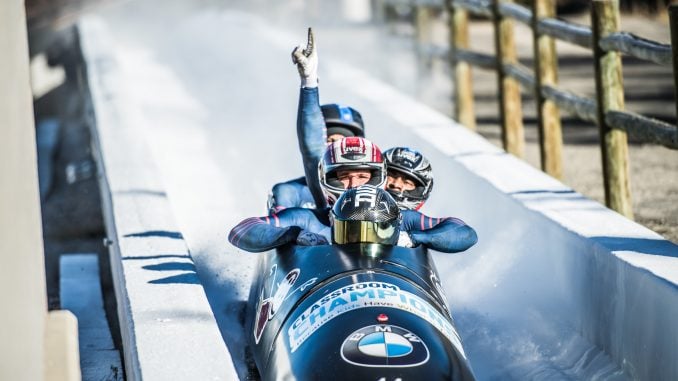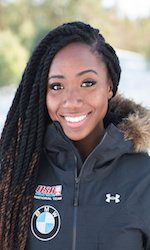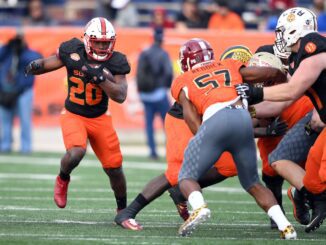
For as long as she can remember, Briauna Jones has dreamed of representing her country in the Olympic Games. It’s a goal that could become a reality this week. Only not the way the former UNC Charlotte track star envisioned.
In her mind’s eye, Jones pictured herself throwing her arms into the air in triumph as she landed in a pit of pure white sand at the end of a medal-winning long jump. Instead, her reality now consists of a shiny red, white and blue bobsled firing off a spray of snow and ice as it speeds across the finish line following a successful run.
Jones is one of two North Carolina residents vying for spots on the U.S. Bobsled team at the upcoming Olympics in Pyeongchang, South Korea. She is the brakeman on a sled driven by teammate Elana Meyers Taylor. Reidsville’s Adrian Adams, a former NC A&T football player, is trying to earn a spot as a pusher on a four-man men’s sled.

They will learn their Olympic fate this weekend when the U.S. team for Pyeongchang is named following a World Cup event in St. Moritz, Switzerland.
“The United States is a really competitive country in any sport and bobsled is no different,” said Jones, a 25-year-old who graduated from Charlotte in 2014 with a degree in anthropology. “On a team with ladies who come from very different backgrounds and who are very talented, it’s going to be a tough one with who makes the team. At this point, it’s all about executing in these final days.”
The U.S. is guaranteed of having two sleds in the Olympic women’s competition. A third can still qualify based on World Cup standings after this week.
Jones strengthened her chances of getting to South Korea last week at an event in Altenberg, Germany. Although her sled finished 11th overall in the competition and second among American finishers, her start times of 5.54 on the first run and 5.57 on the second were the two fastest in the entire field.
Adams’ hopes for making the U.S. team are more of a longshot after lower back and hamstring injuries sidelined him for a large portion of the 2017 season. Even if he doesn’t get chosen this year, he’s committed to staying involved in the sport through the next Olympic cycle with an eye on competing in Beijing in 2022.
Adams and Jones are part of a growing trend in which American bobsledding has turned to former track athletes and football players—- many of them African-Americans — in hopes that their speed and athleticism will help improve starting times.
It’s a strategy that gained popularity in 1992 with Hall of Fame running back Herschel Walker and has helped the U.S. win 10 medals over the past four Olympics after going a half century winning one.
Adams’ father Randy Russell was among the first wave of newcomers to the sport, and it was his influence that got his son into a sled once it became obvious that a career in professional football wasn’t in the cards.

Adams was a wide receiver and defensive back who helped Reidsville High to consecutive state championships in 2002-03 before moving on to A&T. He played briefly for the Huntington Hammer of Arenafootball2 and had several tryouts with Canadian Football League teams, but nothing ever came of them.
“Once I was done pursuing football, I wasn’t done being an athlete,” the now 30-year-old Adams said by phone from Lake Placid, N.Y., where he is preparing for a competition this weekend.
“My dad was like, ‘maybe you should try bobsled,’ so I went to a combine or two and the coaches liked what they saw. I’ve been at the spot since 2012 and I’ve fallen in love with it.”
Jones’ path from the running track to a frozen one was similar to that of Adams.
After a successful career as a jumper and short-distance sprinter for the 49ers, she set her sights on representing the U.S. at the 2016 Summer Games in Rio, but fell short of her goal. Disappointed, she was prepared to give up on her dream until her college track coach Bob Olesen — who was a member of the 1998 U.S. team in Nagano, Japan — approached her with an idea that rekindled her Olympic ambition.
“I saw a lot in her that played into my decision years ago.” Olesen said. “She was a successful track athlete who never achieved everything she wanted, but still had that fire to achieve something.
“She had a lot of the physical qualities that would be successful for bobsledding. After a couple of years of trying options to continue athletically, this was something really stood out.”

Jones went to a Combine for prospective bobsledders in Columbia, S.C., during the summer of 2016 and was the only candidate selected to train with the U.S. national team. As the squad’s only rookie, she earned her first international medal in November 2017, finishing third with pilot Brittany Reinbolt at a competition in Whistler, Canada. A month later, she and Meyers won a World Cup gold medal in St. Moritz.
Her job is to use her strength and speed to get the 400-pound sled moving down the course, then go along for the ride until hitting the brakes at the bottom.
“Your arms are locked in pushing the sled, but your legs are really the engine,” she said. “It’s very lower body and core engaged, a lot like track and field.
“Every track is different and ice conditions also change things, the way the sled moves. On super cold days, the start will be kind of sticky and it’s not as easy to get the sled moving. On warmer days when it’s melting a little, it will be super fast.”
Those warmer days are Jones’ favorite. And not just because of the positive effect they have on her start times.
“I really hate cold weather,” she said. “There’s a certain level of getting used to it. When it’s 20-30 degrees, I feel like I’m more adapted to it than before. But negative temperatures never get easy. When it’s negative-20 outside, there’s no way to mentally get through that without being reminded how cold it is.”



